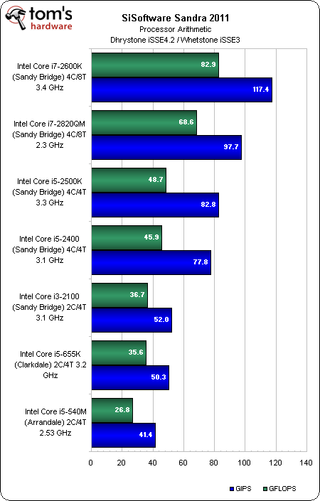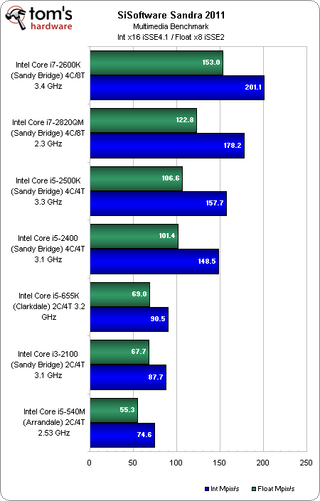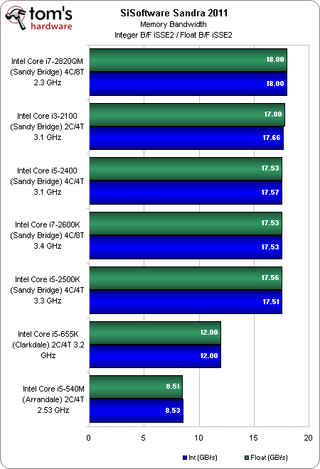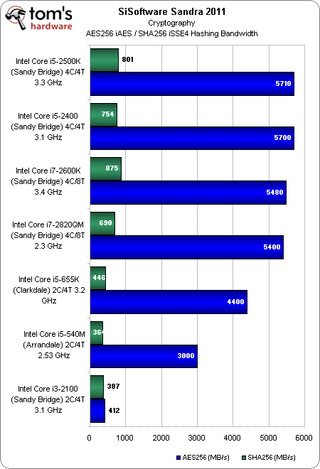Benchmark Results: SiSoftware Sandra 2011





Today's Intel processors deliver solid integer performance, and the Core i7-2820QM is no exception to this trend. What it lacks by way of a slower base clock rate, it makes up thanks to Turbo Boost and Hyper-Threading, which explains why it falls right behind the i7-2600K and ahead of the i5-2500K in both the Arithmetic and Multimedia benchmarks.
We said this before, but the Cryptography test naturally favors the Intel CPUs with AES-NI support. It’s notable that AES hashing bandwidth is actually higher in Sandy Bridge than it was back on Clarkdale. This was something that Intel announced back at IDF 2010, and we see that claim quantified here. Also, bear in mind that the new second-gen Core i3s—just like the first generation—ship with AES-NI disabled. That’s why the Core i3-2100 falls into last place. We have only been able to confirm that the desktop Core i3 lack this feature, but we expect that mobile Core i3s will likely miss it as well.
Stay on the Cutting Edge
Join the experts who read Tom's Hardware for the inside track on enthusiast PC tech news — and have for over 25 years. We'll send breaking news and in-depth reviews of CPUs, GPUs, AI, maker hardware and more straight to your inbox.
Current page: Benchmark Results: SiSoftware Sandra 2011
Prev Page Benchmark Results: 3DMark Vantage Next Page Benchmark Results: Content Creation-
one-shot What are the numbers for battery life for idle, surfing the web, and watching HD video? Several reputable sites have posted up numbers and I'm not seeing a chart that states these numbers, just lots of performance numbers to reiterate the obvious that it's more powerful and more efficient than Arrandale CPUs.Reply -
acku This isn't a production notebook so battery life pertaining to this specific notebook is rather pointless in relation to other models. There are other factors at play: LCD panel, battery density, etc... However, platform power consumption numbers are posted on the second to last and last page.Reply
Andrew
TomsHardware -
one-shot ackuThis isn't a production notebook so battery life pertaining to this specific notebook is rather pointless in relation to other models. There are other factors at play: LCD panel, battery density, etc... However, platform power consumption numbers are posted on the second to last and last page.AndrewTomsHardwareReply
That isn't what I was looking for. On Anandtech and Tech Report, a Compal notebook with a Core i7 2820QM achieved between six and seven hours of battery life when web browsing. I was looking for a comparison to help me make a more informed decision.
Something like these is what I was referring to.
http://www.anandtech.com/show/4084/intels-sandy-bridge-upheaval-in-the-mobile-landscape/9
http://techreport.com/articles.x/20294/8
Battery life is not pointless in any way. A pre-production model or not, it's relevant. If helps give us, the consumers, a better perspective to how laptops with these CPUs will perform with regards to battery life.
I'm surprised it wasn't included.
-
acku Fair point and I completely agree that battery life is not pointless. But on our point, we did go over power as far as browsing and Flash video if you read our conclusion.Reply
On an platform level, you can expect a new Sandy Bridge Core i7 to achieve roughly double the battery life of a notebook with an Arrandale Core i5.
What I disliked about the previous benchmarks (including the ones you referenced) was that they automatically handicapped the benchmark against the Sandy Bridge mobile platform. Forget the whole DTR argument. A 17.3" panel will generally consume more power than a 15.6" (Look at the notebooks it was compared against.) When you isolate it down to the platform level then you can say all-else-being-equal (LCD, hard drive, wireless card, etc...), a notebook based on a Sandy Bridge mobile processor will ~ double battery life. Those other sites showed a roughly 33% improvement because of the other variables at play.
Remember though that when you are talking about H.264 playback, this is all run through the hardware decoder. You are getting very little battery burn no matter what hardware you are running. What really matters then is the total platforms power consumption and the density of your battery (2.6AH vs 2.9AH cells).
But back to your main point, if that is what you want to see on a DTR, then we will include it next time. Frankly, I'm more interested in the battery life of non-DTR mobile CPUs. "Normally" people don't care about battery life on a 17.3" mobile workstation.
-
bearclaw99 Damnnnnn...those are some amazing benches for a laptop CPU. Beats some of the desktop i7s and probably all of AMDs desktop chipsReply -
SteelCity1981 ReplyIf AMD is paying attention, it needs to get its act in order. Brazos is one step up from being a pawn in the AMD Fusion chess set.
AMD's Brazos platform is very impressive especially the E-350 series that's paired with an Radeon HD 6310 in gaming performance. Soo impressive in fact that the gaming performance rivals that of Core i5 661 in a lot of games and even goes toe to toe with the Core i5 2500k in some games like Call OF Duty Black Ops! As show here....
http://www.anandtech.com/show/4134/the-brazos-review-amds-e350-supplants-ion-for-miniitx/5 -
_Pez_ amd is losing ground.. they are taking too long releasing new products.. Intel is expensive.. damm!Reply -
hardcore_gamer I think bulldozer will be able to compete in terms of TDP because of the two integer units / coreReply -
Vadim_79 I just bought myself an Asus N53SV a couple of days ago, so far it's been great, it can handle any game i throw at it due to the combined intel 3000 and gf540m. Whenever i use the notebook for things like surfing the web it uses the intel 3000, so i get better battery life. I game with the notebook plugged in and set to maximum performance on a 42 inch plasma through hdmi. And it beats my desktop as far as framerates are concernedReply
Most Popular

